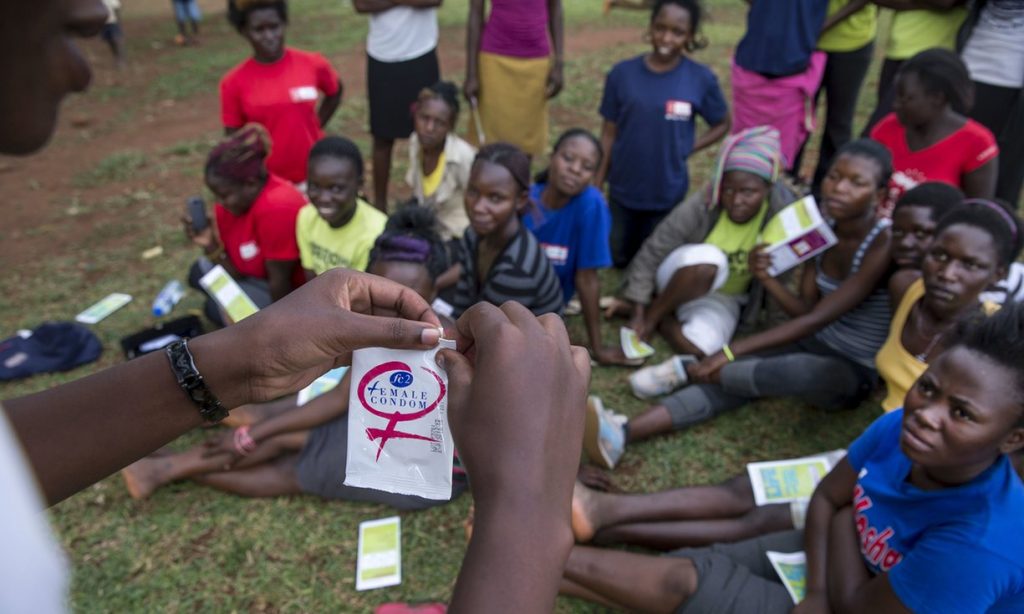
Photograph: Jonathan Torgovnik/Getty
Countries with the lowest take-up of contraception will need to increase spending on family planning to meet international targets.
At the halfway point of Family Planning 2020 (FP2020), an ambitious initiative to increase access to modern contraception for 120 million more women and girls in 69 target countries, organisers said national governments need to allocate more money in their health budgets for contraceptives amid concerns that donor funding could begin to fall.
FP2020 was launched in 2012 as a result of the London family planning summit, where donors pledged $2.6bn (£2bn) over eight years and governments agreed to spend more on contraceptives and scale up services. Since then, donor funding has increased by more than 30%, from $1.1bn in 2012 to $1.4bn in 2014, the last year for which figures are available.
But in the past year, some donors have begun to redirect their overseas aid budgets to support increasing numbers of refugees at home.
It emerged this year that the UN population fund, UNFPA, the main provider of contraceptives to the 69 countries, faces a $140m shortfall in its core budget as some of its largest donors cut funding.
“Everybody is concerned about [funding] as many countries consider moving [overseas development assistance] to domestic budgets,” said Beth Schlachter, executive director of FP2020. “We’re all waiting to see what happens.”
She said relying on donors for money is not sustainable and governments need to reflect their commitment to family planning in their health budgets. “Domestic mobilisation has to be a key to this. Family planning, domestically, has not received the same share as other development areas.”
Joshua Lozman, deputy director of programme advocacy at the Bill & Melinda Gates Foundation – one of the four core partners in FP2020 – said raising more money at a national level is a “primary focus”.
“Within current budgets everyone has to make trade-offs and [there is] a compelling case for family planning,” he said.
Increased use of family planning can help achieve other development goals. It can result in fewer unintended pregnancies, cut maternal and child deaths, and prevent unsafe abortions. It can also give women more control over their lives and the chance to work.
“Family planning doesn’t sit on an island. Lots of things [related to] women and children’s health have to be budgeted for and this has to be part of the broad conversations,” said Lozman.
Uganda is one example of where state support hasn’t matched initial promises. At the 2012 summit, Uganda’s president pledged to increase government funding for family planning, mobilise more money from donors and streamline the national medical supply systems to improve delivery of contraceptives.
But, four years on, government commitments are still dependent on donor funding. Over the two financial years following the London summit, spending on reproductive health commodities in the country shot up from 8bn shillings (£2m) to UGX 25.7bn. But this was largely because of funding from a World Bank project that included procuring reproductive health products. As that funding dried up, the government allocation for 2015-16 dropped back to UGX 8bn.
Across the world, logistical challenges remain another stubborn barrier to family planning. Even with more money, a lack of trained healthcare workers to raise awareness of the types of contraception available and cultural taboos around sex make reaching targets difficult.
A recent report by the Guttmacher Institute found that fears about the side-effects and health risks of using contraceptives deterred women from using them.
Babatunde Osotimehin, executive director of UNFPA, said reaching young people is crucial. He said in the target countries, up to 70% of the population are under 35. “The largest number of new infections for HIV is adolescent girls in sub-Saharan Africa, which implies the need to do something,” he said.
“Programme countries must step up to the plate … We need to have them understand that they must budget for sexual and reproductive health services because if we have enough services … family planning will reduce maternal mortality. They must budget regularly, make money available and we must continue to advocate for that.”
The latest FP2020 progress report, published in November, said 24 million more women and girls are now using family planning, with more than 290 million users in the 69 countries. However, at the current rate of progress, the target will be missed by 2020.
But Lozman said he is “confident we will see significant progress” over the coming years. The UN general assembly promised last year to ensure universal sexual and reproductive healthcare, including family planning, by 2030 under the new sustainable development goals.

